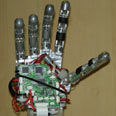
SmartHand. Can also play piano
צילום: פרדריק סבליוס
Israelis help develop revolutionary prosthetic hand
(Video) Man-Machine interface developed in collaboration with researchers at Tel Aviv University leads to breakthrough allowing a Swedish patient to sense fingers again, perform complicated functions after short training
VIDEO - The future is already here, and big time: Scientists from several European countries and Israel have developed a prosthetic hand which functions like a real one: Amputees can write with it, type on a keyboard, play piano and perform other fine movements.
Another amazing advantage is that the prosthesis has sensors which enable real feeling in its fingertips.
The scientists are planning to create prosthetic legs of the same kind. The futuristic prosthesis, called SmartHand, is expected to change the lives of many handicapped people, whose hands or legs were amputated as a result of accidents, wars or diseases.
The revolutionary prosthesis took years to develop, and its production is said to cost tens of millions of euros. Its developers are scientists from, Ireland, Italy, Iceland, Denmark and Israel.
The first lucky person be fitted with the prosthesis was Robin af Ekenstam, A young Swedish amputee. He has been using it for several months now. He says he feels like it's his real hand.
Ekenstam told Swedish TV, "When I grab something hard, then I can feel it in the fingertips, which is strange, as I don’t have them anymore. It’s fantastic."

Ekenstam with is new hand (Photo: Fredrik Sebelius)
So how exactly does this unbelievable wonder work? The prosthesis is comprised of four electric motors and 40 sensors. After the organ was amputated, the scientists attached the prosthesis, using a very thin electronic thread, to nerves located above the amputated limb. This way, the prosthesis is connected to the amputee's brain.
From this point it all becomes pretty simple. When the prosthesis owner wants to type on a keyboard, for example, his brain sends a command to an interface inside the prosthesis.
From there, the translated command is transferred to the sensors in the prosthesis, and its owner can then perform fine movements like playing a musical instrument, drinking, eating and button their clothes. Such activities are nearly impossible for people with a normal prosthesis.
Bionic shape
At this stage, it is still unclear when the advanced prosthesis will be marketed to the public and what it will cost.
And as for the device's bionic shape, the plan is to have the prostheses created in the future look like real limbs and be covered with artificial skin.
"We managed to connect neural commands in the amputee's amputated arm, which allowed him to perform complicated activities like eating and writing, so in fact, we managed to wire his brain," says Prof. Yosi Shacham-Diamand of Tel Aviv University's Department of Engineering. Diamand led the team of Israeli scientists that created the man-machine interface – the part connecting between the disabled person's brain and SmartHand.
He said the prosthesis itself was planned and created by scientists from the University of Pisa in Italy. "There are wonderful Italian mechanics," he noted. "There is no doubt that what we have here is a breakthrough which will allow amputees in the future to function better with a prosthetic hand or leg in a way which has not been familiar until now."
Tamar Trabelsi-Hadad contributed to this report










